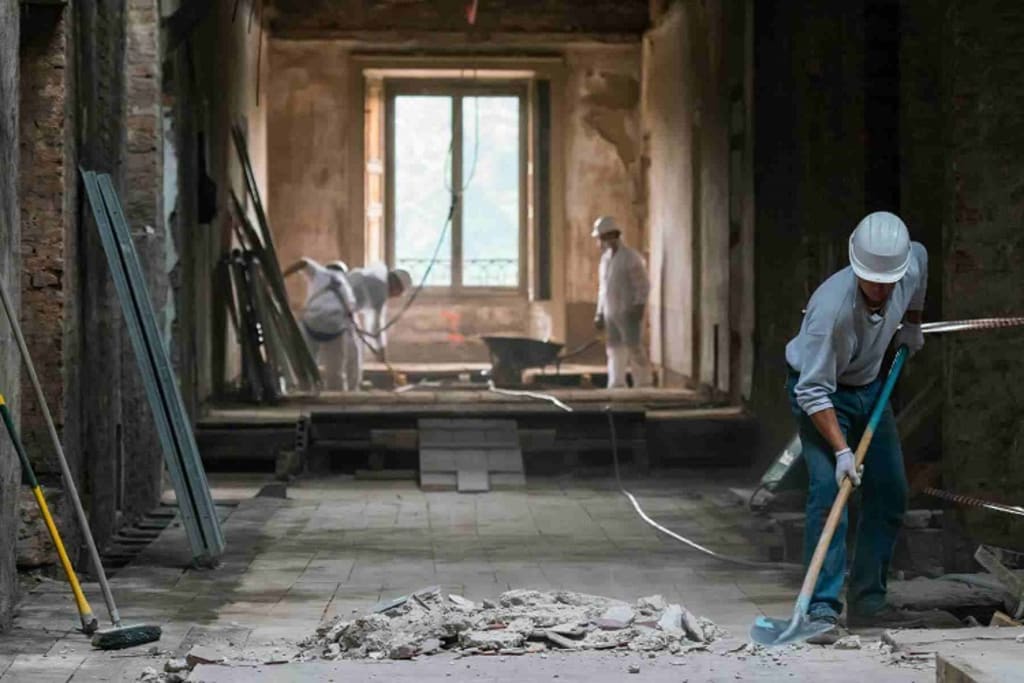Fire and Water Restoration Process: What you Should Do After a Fire Damage
10 things To Do in The Fire and Water Restoration Process

According to the National Fire Protection Association (NFPA), fire departments respond to nearly 350,000 homes annually. A fire can start in an instant and continue to rage until its trigger runs out. After a fire breakout, the effects can destroy homes and properties, cause major injuries or civilian deaths in seconds.
Fires are one of the most devastating events ever. The damage they leave behind is devastating and painful too. Fire damage is the architectural or cosmetic damage on your residential or commercial property due to a fire. After going through fire damage, it is important to understand the fire and water restoration process to ease the trauma and anxiety.
The good news is, if you have a fire-damaged home, it is possible to restore it to look like new. First, it is important to understand the types of fire damage and the restoration process. In this article, we will discuss what to expect when you have a fire-damaged home.
Types of Fire Damage
Fires are mostly caused by electrical or appliance malfunction, household accidents, or flammable substances. After the flames, the property damage types to examine are the water and fire damages left behind.
Water damage
The water that is used to extinguish fires causes damage to property and belongings. The fire hose produces a huge amount of pressure to put out the extensive damage. Compared to the sprinkler systems, which work immediately after a fire, the hose is more damaging. The water used on both equipment to put off the fire is generally damaging.
Such water damage leads to the growth of mold, which is a health hazard to the occupants. The mold will also eat away the drywall, floorboards, and wood, weakening the structure of your home.
Fire Damage
The flames from the fire destroy cabinets, furniture, belongings in minutes. The flames from fires can create dangerous conditions. Sometimes the extent of danger is so bad that one can barely recognize anything.
Smoke Damage
Smoke and soot are corrosive byproducts of fire that lead to foul smells and discoloration in your home. The smoke settles into clothes, furniture, or walls leading to a thick film coating.
The Fire and Water Restoration Process
1. Call Your Insurance Company
It is important to notify your insurance agent about the fire damage on your property. He/she may inspect the damages and advice you on how much you can use on repairs as well as your policy limits.
Chances are, your home will be inhabitable after fire damage, so your insurance should cover temporary living as well as food expenses.
2. Document the Damage
Ensure you take pictures and videos of the fire damage on your property. Document a list of the items that may have been ruined by fire/water. Also, document anything that has been affected by mold as a result of water.
This information will be served as proof for your insurance provider. It also helps with the faster processing of insurance claims, making things easier for you.
3. Remove all Damaged Components
The water and fire restoration process start with throwing away all unsafe components that cannot be restored. Any dangerous items that can lead to cuts or health issues should be thrown away immediately.
4. Air out Your Property
The most effective way to eliminate the smoke smell quickly is to air everything out. Open all the windows, cabinet doors, and drawers to let air flow evenly throughout the house. Turn on the fans facing the window to help speed up the process.
Remove the soaked rugs and carpets to prevent the floor from further damage and foul smell. If you want to prevent further damage from damaging the furniture, place a foil beneath the furniture's legs or bottoms.
5. Treat for Bad Smell
The good old use of baking soda has proven to be a popular method of eliminating bad smells. Sprinkle a good amount of baking soda on the furniture, carpets, drapes, and pass-through with a broom. Let it absorb as much of the smell as possible, especially overnight, preferably outside.
6. Clothing, Curtains, and More
Put any machine-washable clothes in the laundry immediately. Use any soap detergent but consider adding vinegar to your rinse water. Vinegar helps eliminate the smells. You may also consider using white vinegar and water to create a solution for cleaning your surfaces after water damage.
7. Remove or Restore the HVAC System
Removing the HVAC system ensures that no harmful particles will spread through the air and cause harmful health problems.
8. Water Damage Removal
If there is excessive water on your property, don’t use a vacuum to remove it. It would be best if you never used wet appliances because of the electric dangers involved. An effective method of removing excess water from your home in such a scenario is by using a sump pump.
9. Evaluate Structural Framing
Some rooms in your house may have been structurally damaged as a result of water/fire. Be watchful and don’t go into any rooms that have structural damage to avoid self-harm.
10. Contact Professional Services
Because of the dangerous impacts of fire damages and the dangerous chemicals required to clean up the mess completely, a professional will be needed. You will need to trust the fire and water restoration professionals as they have the equipment, clothing, chemical, and disposal techniques to safely and thoroughly handle any damage.
Immediate action is important to prevent the damage from spreading and worsening over time. In the case of mold growth, water damage, and restoration, experts can be contacted for help.
Fires can happen at any given time; no one plans for such disasters. Every fire is different and burns at a different intensity because different materials fuel it. Each of these fires was distinguished in different ways. These factors determine the fire mitigation and water restoration process and the techniques that will be most effective.
You can trust your restoration team to make your house a home again and rely on them to do what is best for your home.






Comments
There are no comments for this story
Be the first to respond and start the conversation.